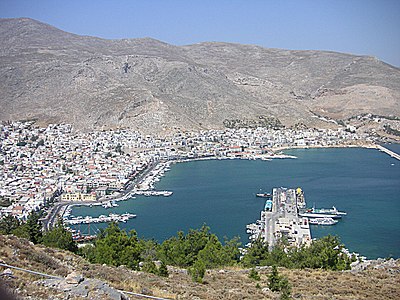| Revision as of 08:17, 17 March 2006 edit213.5.29.128 (talk)No edit summary← Previous edit | Revision as of 09:33, 19 March 2006 edit undo133.45.89.90 (talk)No edit summaryNext edit → | ||
| Line 1: | Line 1: | ||
| ] | ] | ||
| '''Kalymnos''' (]: Κάλυμνος) is a ] island in the south-eastern ]. | '''Kalymnos''' (]: Κάλυμνος, Turkish: Kilimli) is a ] island in the south-eastern ]. | ||
| The capital of Kalymnos, situated in a natural amphitheatre, is Port of Pothia. | The capital of Kalymnos, situated in a natural amphitheatre, is Port of Pothia. | ||
Revision as of 09:33, 19 March 2006

Kalymnos (Greek: Κάλυμνος, Turkish: Kilimli) is a Greek island in the south-eastern Aegean Sea.
The capital of Kalymnos, situated in a natural amphitheatre, is Port of Pothia.
The town features Italianate architecture, a silver-domed cathedral, and the Monastery of St. Savas, perched on a hilltop overlooking the town.
Sponge diving is a traditional occupation in Kalymnos, with related exhibitons, along with other local folklore, at three local museums.
Kalymnos is neighboured by the small island of Telendos, which was part of Kalymnos, but after a major earthquake 554 A.C. was split and separated from Kalymnos by a strip of water (about 800m wide)
Earthquakes are not a frequent occurrence around Kalymnos. There is also a dormant volcano in the centre of the island near the town of Kadoumni.
Kalymnos is one of the twelve Dodecanese islands located in the Aegean Sea. It is very close to Kos, the most significant of the twelve islands.

Kalymnos is a rocky island with very few cultivable areas; goat heading is the main farming activity. Limestone cliffs with a multitude of caves and overhanging areas have made Kalymnos a world class destination for rock climbers; and more specifically for sport climbing. The huge yellow cave full of stalactites above the town of Masouri (The "Grande Grotta") and the long and tall walls that surround it are most popular.